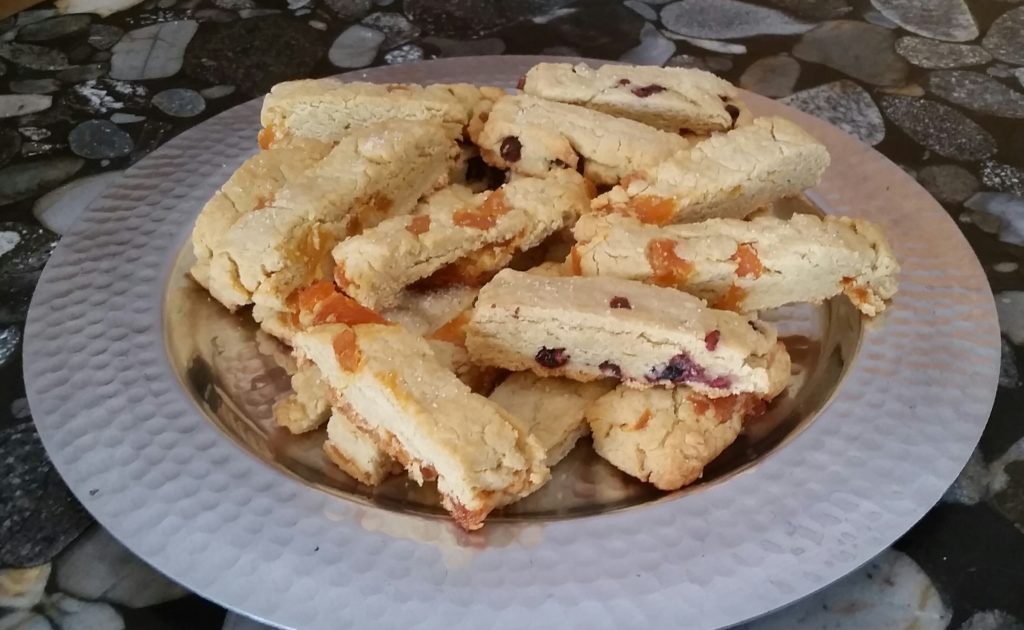The children’s song goes, “Tu B’shvat is coming… the holiday of trees… Tu B’shvat is coming… the holiday of trees…” That’s really the only line of the song I know, but it covers the most critical details of the story for me.
It is time, once again, to get our Tu B’shvat on. This year I am prepared to celebrate the way all good Jewish holidays should be celebrated: with food.
For me, there is nothing more fitting for Tu-b’shvat than making mandelbread filled with nuts, carob chips, and dried fruit. Mandelbread is an almond-flavored cookie but from there you can really make it your own. This pareve mandelbread recipe is a fantastic project for kids to do with a grown up, but before you begin baking, you must decide what you want to put into your cookies. I encourage you to get creative. From filling to texture, it is a cookie that can be perfectly tailored to your taste. For example, my beloved mother-in-law prefers her mandlebread crunchy like biscotti, while my sons like theirs filled with as many carob chips and fruit as can fit. Many traditional Tu-B’shvat fruits can be incorporated into mandelbread: almonds, figs, carob chips, dates – it’s all delicious.
Yield 24
INGREDIENTS
- 4 1/2 cups all-purpose flour
- 1 cup sugar (I use a ½ cup of Stevia and they turn out great)
- 2 teaspoons baking powder
- 1/2 teaspoon salt
- 1 to 1 1/2 cups chopped nuts, carob chips, dried fruit, or other mix-ins of your choice (chop as needed)
- 5 large eggs
- 1 cup vegetable oil
- 1/2 teaspoon vanilla extract
- ¾ teaspoon almond extract
DIRECTIONS
- Preheat the oven to 350 degrees F. You will need baking sheets; I like to use a silicone liner on each baking sheet.
- Whisk together the flour, sugar, baking powder, and salt in a mixing bowl. Stir in nuts, carob chips, dried fruit, and anything else you want to fill your mandelbread.
- Whisk together four of the eggs, the oil, and the vanilla/almond extracts in a medium bowl until well incorporated.
- Combine the wet and dry ingredients. If the mixture seems too dry, stir in the remaining egg. Though the dough will be a bit sandy, it should hold together; I typically use all five eggs. Use your hands and a bit of extra flour to knead the dough to ensure it is uniform.
- Divide the dough into quarters and bake two loaves per cookie sheet. Work each section of dough into a rectangular(ish) shape 8 to 9 inches long and about ½ inch high. The dough will be a bit oily and will have some tension to it; feel free to use a rolling pin. Before placing the mandelbread in the oven, score the surface of the dough where you will cut each loaf approximately 6 times. This will make the cookies easier to cut before the final baking.
- Bake one sheet (two loaves) at a time for 15 to 20 minutes until the mandelbread loaves are dry to the touch on top; the center of the bread should not be cooked through. Remove from the oven and transfer each semi-baked loaf to a cutting board. Cut along scored marks.
- Re-bake for 10 minutes or longer, depending on how crisp you like your mandelbread.
- Transfer the slices to a wire rack to cool completely.
Finally, although the dough itself is parve, my grandmother always felt a good mandelbread should be covered with butter, sprinkled with sugar while hot, and always eaten in good company.













